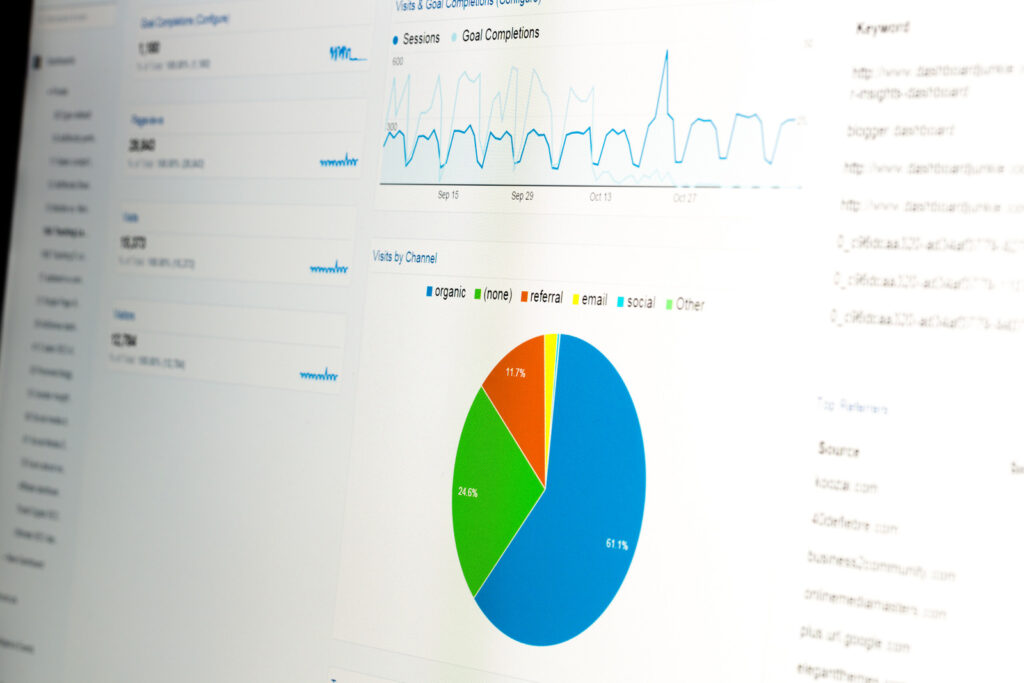Key Takeaways
- Use Analytics for Insights. Know the power of Google Analytics. It tracks your blog’s performance and audience.
- Sign up for Google Analytics. Then, integrate it with your Blogger website to start tracking traffic.
- Customize Classic Templates. You can add Analytics to them by inserting the tracking code in the HTML editor.
- Configure Newer Templates. Do this by accessing the Theme settings and pasting the tracking ID.
- Use Google Tag Manager to add Analytics and tracking codes to your Blogger site. It is an efficient way to do this.
- Improve SEO with Data. Use Analytics to understand users. Then, use that insight to enhance your blog’s SEO.
Did you know that 80% of bloggers overlook Google Analytics? It has the potential to supercharge their online presence. Dive into this goldmine of insights. It can skyrocket your blog’s performance and reach heights you never thought possible. Google Analytics gives you the tools to succeed. You can use it to see your audience’s demographics. You can also use it to track which content they like. With this data, you can make informed decisions and drive success. Join us as we unravel the mysteries of using Google Analytics for bloggers. This will help you improve your content strategy. It will boost engagement and meet your blogging goals.
Understanding Google Analytics for blogger

Analytics Tools Purpose
Bloggers find Google Analytics crucial. It offers insights into their website’s performance. Knowing this tool is key. It helps improve content and reach more people. Bloggers can use Google Analytics to track how visitors behave. They can see where traffic comes from and how engaged visitors are. This helps them improve their online presence. The main goals of using Google Analytics are to improve user experience. They are also to increase website traffic and boost conversion rates.
Analytics Tools Benefits
The advantages of using Google Analytics for bloggers are immense. Exploring this tool allows bloggers to analyze audience demographics, behavior patterns, and interests. Bloggers can tailor their content to meet reader’s needs. They do this by gaining insights into what readers like. Also, Google Analytics lets bloggers see how well marketing campaigns are doing. It helps them find ways to improve their content strategy.
Analytics Tools Key Metrics
Bloggers should track key metrics in Google Analytics. They gauge how well their efforts work. You must learn about key metrics. They include bounce rate and session duration. They are vital for understanding visitor engagement. A high bounce rate means visitors leave. A longer session duration shows active user interaction. Monitoring page views and unique visitors provide valuable data. It shows how well the content is doing and how large the audience is.
Signing Up for Google Analytics Account
Account Creation for Blog Analytics
Bloggers must create a Google Analytics account. It is key for tracking their website’s performance. To start, visit the Google Analytics website and click on “Start for free.” Then, log in using your Google account or create one if you don’t have it yet. Next, set up your account. Enter your account name, website name, URL, industry category, and time zone. Once done, agree to the terms and conditions and click on “Create.”
Setting up an account is crucial. It lets bloggers track key metrics, like page views, bounce rate, and user data. By making an account, bloggers can learn valuable things. They will learn about their audience’s behavior and preferences. This information is vital for tailoring content strategies and optimizing blog performance.
Blog Analytics Property Setup
After creating an account, the next step is to set up properties in Google Analytics. This is for tracking blog data well. To do this, click on “Admin” in your Google Analytics dashboard, then select “Create Account.” Next, enter your website name, URL, industry category, and time zone. After that, choose a reporting time zone and click on “Next.”
Linking blog properties to Google Analytics ensures accurate data collection. By setting up properties , bloggers can see details. They can see details about where their website traffic comes from. They can also see user engagement levels and conversion rates. This information helps bloggers make informed decisions on content creation and marketing strategies.
Data Views for Blog Analytics
Managing data views in Google Analytics is crucial for analyzing blog performance. To create a new view, go to the Admin section of your Google Analytics account. Then, select “Create View.” Customize the view to your preferences. Do this by selecting metrics and dimensions that matter to your blog analysis.

Customizing data views lets bloggers focus on parts of their blog performance. They can focus on things like traffic sources, user behavior, and goal completions. Understanding the role of data views is key to tracking blog performance. They help bloggers find areas to improve. Then, they can use them to make the user experience better.
Integrating Analytics with Blogger
Google Analytics Tracking Code ID Overview
A tracking ID is a unique code. Google Analytics assigns one to each account for tracking blog traffic. It plays a crucial role in monitoring the performance of your blog. To find your tracking ID, go to the Admin section of your Google Analytics account. Once you find it, put the tracking ID into your blogger settings. This will let you start monitoring blog traffic well.
Bloggers must understand the tracking ID overview. It is key for analyzing their audience’s behavior and engagement. Using this ID, you can learn which content your readers like. Then, you can improve future posts.
Google Analytics for Blogger Settings
Configuring your blogger settings is a key step. It lets you integrate Google Analytics for efficient blog traffic tracking. Begin by accessing the Settings tab on your Blogger dashboard. From there, go to the Other section. Find the Google Analytics field there. You can input your tracking ID there.
Setting up preferences in Blogger ensures accurate data tracking. It lets you delve deep into visitor data. This data covers demographics, behavior flow, and popular blog content. Align proper blogger settings with Google Analytics. This paves the way for analysis. It supports informed decisions based on real-time insights.
Adding Analytics to Classic Templates
Locate Tracking ID
Finding the tracking ID in Google Analytics is key. It is crucial for monitoring blog performance well. To locate it, first, log in to your Google Analytics account and select the Admin tab. Then, go to the Property column. Click on Tracking Info under Property Settings. Here, you will find your unique tracking ID, which usually starts with “UA.”
Finding the tracking ID is key. It captures and analyzes all data from your blog. Without this key identifier, Google Analytics can’t track key metrics. These include page views, bounce rates, and user demographics.
Finding the tracking ID is a key step for setting up Google Analytics for your blog. It connects your website to the analytics platform. This ID lets Google Analytics collect data from your blog. It presents the data in reports and insights.
Template Editing
You must edit templates. This is necessary to add Google Analytics tracking code to your blog well. First, access your blog’s HTML editor. There, you can insert the tracking code from Google Analytics. Customize the template by placing the code before the closing tag.
You customize blog templates to add Google Analytics. This ensures the tracking code is on every page of your blog. This process enables thorough data collection across all pages. It gives you a complete view of visitor behavior on your blog.
Editing the template is vital. It ensures a successful setup of Google Analytics on your blog. Embed the tracking code in your template. This ensures recording every visitor interaction. It lets you make informed decisions based on real-time data.
Configuring Newer Blogger Templates
Accessing Layout
Accessing the layout section in newer Blogger templates is key. It allows you to integrate Google Analytics. Bloggers can navigate to the layout tab located within the Blogger dashboard. Once there, they can find the option to add new gadgets and customize their blog’s appearance.
Understanding where to find the layout section is key. Bloggers need it to place tracking codes right. Bloggers can use this feature to place their Google Analytics code in the right location. This will help it work well.
A guide explains how to find the layout section. It can help bloggers. They can start by logging into their Blogger account. Then, they should go to the “Theme” section in the dashboard. From there, they should select “Edit HTML” to access the template code. They can then insert the Google Analytics tracking code.
Adding Widgets
Adding widgets is key. They enable Google Analytics on a blog. Bloggers can check their website’s performance well. They can do this by adding special widgets for displaying analytics data. Customizing these widgets allows bloggers to showcase real-time data on their blog.
Customizing widgets shows data. It gives bloggers real-time insights into their website traffic and audience. This feature lets bloggers track key metrics. These include page views, unique visitors, bounce rate, and more. They can do this without leaving their blog’s interface.
The importance of adding widgets lies in real-time data monitoring capabilities. With these widgets in their blog, bloggers can view key metrics. They won’t have to switch between tabs or platforms. This seamless integration enhances user experience and simplifies the monitoring process.
Google Tag for Blogger
Understanding Google Tag
Google Tag Manager is a tool that simplifies the process of managing tags on a website. It allows bloggers to add and update snippets of code on their blogs. This helps track activities and metrics. It gives valuable insights into audience behavior.
Implementing Google Tag Manager offers several benefits. Bloggers can add tags without needing to change the website’s code. Additionally, it streamlines the tag management process, ensuring accurate tracking data. Moreover, it provides a centralized platform for managing all tags in one place.
Google Tag plays a crucial role in advanced tracking techniques for bloggers. It allows for complex tracking codes. These include event tracking and e-commerce tracking. By using Google Tag well, bloggers can gain deeper insights. They are into user interactions on their blogs.
Implementation Steps
To add Google Analytics for bloggers, start by making an account on Google Tag Manager. Next, set up a container for your blog to hold all the tags. Then, install the Google Tag Manager code snippet on your blog’s template.
Ensure correct implementation steps by following each instruction . Make sure to test the installation to verify that tags are firing. This ensures that data is being tracked and recorded for analysis purposes.
Following the implementation steps is vital for successful integration with your blog. Ensure accurate data collection by following each step. It will reflect the true performance of your blog. This enables you to make informed decisions based on reliable data.
Monitoring Google Analytics Reports and Website Performance
Real-Time Data
Google Analytics provides real-time data tracking. It lets bloggers track their website. Bloggers can observe visitor activities on their site in real time. They can see current data on active users, page views, and traffic sources. This feature lets bloggers make timely adjustments. Immediate insights form the basis for them. Bloggers need real-time data. It helps them understand the immediate impact of their posts or promotions.
Bloggers analyze real-time data in Google Analytics. They gain valuable info on visitor behavior. This helps them find popular content and trends. Bloggers can use real-time data to detect sudden traffic spikes or drops. They can then respond to improve user engagement. Seeing how visitors interact with the blog in real time allows for quick decisions. It also allows for content changes to improve user experience.
Real-time data is important. It lets it provide bloggers with instant feedback on their website’s performance. Bloggers can track metrics in real time. These metrics include active users and referral sources. They show how well ongoing campaigns or promotions are working. This quick feedback loop empowers bloggers. It helps them make fast decisions to seize opportunities or address issues.
Audience Insights
Google Analytics offers valuable audience insights that help bloggers understand their readers better. Bloggers can analyze audience demographics, interests, and behaviors. They can use this to tailor their content to meet audience preferences well. Age, location, and interests of website visitors. They allow bloggers to create targeted content. It resonates with their audience.
Using Google Analytics, bloggers can craft content strategies. These strategies cater to specific reader segments. They do this by using insights about their audience. Bloggers can identify popular topics or content formats. They are popular among different audience groups. This helps them create engaging posts. These posts attract and keep readers. Insights about the audience are valuable. They show user behavior patterns. Bloggers can use them to improve their content strategy for impact.
Analyzing audience insights helps bloggers engage users. It also aids in making money through targeted ads. Bloggers can use demographic data and user interests from Google Analytics. They can use this data to attract relevant advertisers. This will help them to increase revenue through targeted campaigns. Understanding what the audience likes is key. It helps in making a strategy to make money that matches what readers like.
Acquisition Reports
In Google Analytics, acquisition reports offer details on traffic sources. They cover user acquisition for a blog. Bloggers can explore acquisition reports. They show which channels drive the most traffic to their website. They can see if traffic comes from organic search, social media, or direct visits. Knowing these acquisition channels is crucial. They are key to improving promotions and maximizing online visibility.
Studying acquisition reports helps bloggers. They can see how well ads or promotions drive traffic to the site. Bloggers track key metrics. These include click-through and conversion rates from acquisition channels. They use these metrics to improve their strategies for better results. Using acquisition reports helps bloggers spend resources well. They find the channels with the highest return on investment (ROI).
Looking at acquisition reports in Google Analytics provides insights. They show how well SEO and digital marketing work for a blog. Bloggers can adjust their tactics to reach more people. They should do this by understanding which channels bring the most users to their site.
Enhancing SEO with Analytics
Blogger Google Analytics Keyword Optimization
Keyword optimization plays a crucial role in boosting blog SEO. By targeting relevant keywords, bloggers can attract more organic traffic to their websites. Studying keywords in Google Analytics provides insight. It shows the terms users search for.
Use Google Analytics to identify high-performing keywords and those that need improvement. Look at metrics like click-through rates and bounce rates to gauge keyword effectiveness. Using analytics data to optimize keywords can improve search rankings.
Blogger Analytics Content Strategy
Developing a solid content strategy is essential for blog success. Google Analytics offers insights into which content resonates most with your audience. Bloggers can analyze metrics like page views, time on page, and social shares. They show what content performs best.
A data-driven approach to content creation can lead to higher engagement and conversions. Use Google Analytics to track the performance of content types. Then, tailor your strategy based on what you find. Understanding your audience’s preferences is key. You do this through analytics data. It helps you create compelling and relevant content.
Troubleshooting Common Issues
Tracking ID Errors
Finding common tracking ID errors is crucial. They are key for accurate data in Google Analytics. Check for typos or missing characters in the tracking ID. This will ensure proper implementation. Ensure you place the tracking code on all relevant pages of your blog.
To troubleshoot tracking ID issues, check if the tracking code is on your website. Ensure you place the code snippet before the closing tag on each page. Use Google Tag Assistant to validate the tracking setup and identify any errors.
Preventing and fixing tracking ID errors is key. Your blog’s performance relies on them to provide reliable insights. Check your Google Analytics account often. Look for sudden drops or spikes in data. Address any discrepancies to maintain the accuracy of your analytics reports.
Data Discrepancies
Understanding data discrepancies in Google Analytics helps you read your reports. Discrepancies can occur for many reasons. These include bot traffic, spam referrals, or mistakes in tracking code. Analyze these factors to pinpoint the root cause of data variations.
You must identify reasons for data variations in analytics reports. This requires a detailed look at your tracking setup and data sources. Compare different data sets within Google Analytics to identify inconsistencies and patterns. Look out for discrepancies in metrics like page views, sessions, or bounce rates.
Resolving data discrepancies is vital for accurate performance analysis of your blog. Add filters to Google Analytics. They exclude irrelevant traffic sources. These sources skew your data. Check your analytics setup often. Make sure it collects accurate data and reports well. Good reporting lets you make informed decisions.
Final Remarks on Google Analytics for Blogger
You’ve now unlocked the power of Google Analytics for your Blogger website. Understand your audience. Optimize your content. Track its performance. Then, you’re set to raise your online presence. Remember to check your analytics often. Use them to make smart choices and improve your site’s visibility. Troubleshooting any issues will ensure seamless tracking of your progress.
Take charge of your blog’s success. Do this by using the insights from Google Analytics. Dive into your data, tweak your strategies, and watch your blog flourish. Your dedication to mastering analytics will lead to more traffic and better engagement. It will make for a more successful blogging journey.
